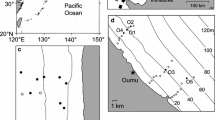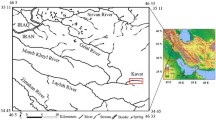Abstract
Laevistrombus canarium is one of the marine gastropod mollusks that have high commercial value, particularly in the aquaculture sector in Malaysia. This study was conducted to determine the feeding and food items of L. canarium at different ontogenetic stages (juveniles, sub-adults and adults) from Merambong shoals, Malaysia. Field observations on feeding activity were conducted, followed by detailed laboratory analysis on the stomach content. Five-minutes observations on randomly selected individuals were conducted at the field sampling site and their feeding activities were recorded with reference to age stage. Various shell sizes from each ontogenetic stage were randomly collected and quickly anaesthetized with ice and preserved in 10% formalin before being transported to the laboratory for stomach content analyses. Field observations showed that L. canarium mainly grazed on epiphytes occurring on seagrass (46.67%), followed by sediment surface (40%) and epiphytes occurring on macroalgae (13.33%). Stomach content analyses showed a significant difference (P <0.05) in gastro-somatic index (Gasi) between the juveniles (0.39±0.05), sub-adults (0.68±0.09) and adults (0.70±0.05) (P <0.05). Food items found in the conch stomach include diatoms, detritus, foraminifera, seagrass and macroalgae fragments, sand particles and shell fragments. The Index of Relative Importance (%IRI) indicates three main types of food dominated the three ontogenetic stages namely diatoms, sand particles and detritus. However, no significant difference (P >0.05) was detected between the three main food items (diatoms, sand particles and detritus) among the ontogenetic stages. Therefore, feeding activity revealed the role of the dog conch in the marine food network. While, classification of the types of food consumed by L. canarium through stomach content analysis determines the particular position of the gastropod in the food chain. Further studies are needed to provide a better insight between trophic relationships of L. canarium with marine ecosystem.
Similar content being viewed by others
References
Abbott R T. 1960. The genus Strombus in the Indo-Pacific. Indo -Pacific Mollusca, 1 (2): 33–146.
Arularasan S, Kesavan K, Lyla P S. 2011. Scanning electron microscope (SEM) studies of radula of the Dog Conch Strombus canarium (Gastropoda: Prosobranchia: Strombidae). European Journal of Experimental Biology, 1 (1): 122–127.
Arularasan S, Lyla P S, Kesavan K, Khan S A. 2010. Recieps for the Mesogastropod-Strombus canarium. Advance Journal of Food Science and Technology, 2 (1): 31–35.
Bujang J S, Zakaria M H, Kanamoto Z, Mohd P A. 2001. Seagrass communities of the Straits of Malacca. In: Japar Sidik B, Arshad A, Tan S G, Daud S K, Jambari H A, Sugiyama S eds. Aquatic Resource and Environmental Studies of the Straits of Malacca: Current Research and Reviews. Malacca Straits Research and Development Centre (MASDEC), Universiti Putra Malaysia, Serdang. p.81–98.
Bujang J S, Zakaria M H. 2003. The seagrasses of Malaysia. In: Green E P, Short F T eds. World Atlas of Seagrasses. California University Press, California. p.152–160.
Bujang J S. 1994. Status of seagrass resources in Malaysia. In: Wilkinson C R, Sudara S, Chou L M eds. Proceedings of the Third ASEAN-Australia Symposium on Living Coastal Resources, Volume 1. Australian Institute of Marine Science, Townsville, Australia. p.283–290.
Castell L. 2003. Marine gastropods. In: Aquaculture: Farming Aquatic Animals and Plants. Fishing New Book. p.467–487.
CFMC. 1999. Queen conch stock assessment and management workshop. Caribbean Fishery Management Council (CFMC), National Marine Fisheries Service, National Oceanic and Atmospheric Administration, Belize City.
Chester C M. 1993. Comparative feeding biology of Acteocina canaliculata (Say, 1826) and Haminoea solitaria (Say, 1822) (Opisthobranchia, Cephalaspidea). American Malacological Bulletin, 10: 93–101.
Cob Z C, Arshad A B, Idris M H, Bujang J S, Ghaffar M A. 2008b. Sexual Polymorphism in a Population of Strombus canarium Linnaeus, 1758 (Mollusca: Gastropoda) at Merambong Shoal, Malaysia. Zoological Studies, 47 (3): 318–325.
Cob Z C, Arshad A, Bujang J S, Amin S M N, Ghaffar M A. 2008a. Growth, mortality, recruitment and yield-perrecruit of Strombus canarium linnaeus, 1758 (Megastropoda: Strombidae) from the west Johor straits, Malaysia. Research Journal of Fisheries and Hydrobiology, 3 (2): 71–77.
Cob Z C, Arshad A, Bujang J S, Bakar Y, Simon K D, Mazlan A G. 2012. Habitat preference and usage of Strombus canarium Linnaeus, 1758 (Gastropoda: Strombidae) in Malaysian seagrass beds. Italian Journal of Zoology, 79 (3): 459–467.
Cob Z C, Arshad A, Bujang J S, Ghaffar M A. 2009a. Age, growth, mortality and population structure of Strombus canarium (Gastropoda: Strombidae): variations in male and female sub-populations. Journal of Applied Sciences, 9(18):3287–3297.
Cob Z C, Arshad A, Bujang J S, Ghaffar M A. 2009b. Seasonal variation in growth and survival of Strombus canarium (Linnaeus, 1758) larvae. Pakistan Journal of Biological Sciences, 12 (9): 676–682.
Cob Z C, Arshad A, Bujang J S, Ghaffar M A. 2011. Description and evaluation of imposex in Strombus canarium Linnaeus, 1758 (Gastropoda, Strombidae): a potential bio-indicator of tributyltin pollution. Environmental Monitoring and Assessment, 178 (1-4): 393–400.
Cob Z C, Arshad A, Ghaffar M A, Bujang J S, Muda W L W. 2009c. Development and growth of larvae of the dog conch, Strombus canarium (Mollusca: Gastropoda), in the laboratory. Zoological Studies, 48 (1): 1–11.
Cob Z C, Arshad A, Sidik B J, Nurul-Husna W H W, Mazlan A G. 2014. Feeding behaviour and stomach content analysis of Laevistrombus canarium (Linnaeus, 1758) from the Merambong shoal, Johor, Malaysia. Malaysian Nature Journal, 66 (1-2): 184–197.
Cob Z C, Japar S B, Mazlan A G, Arshad A. 2005. Diversity and population structure characteristics of Strombus (Mesogastropod, Strombidae) in Johor Straits. I n: Proceeding of the 2nd Regional Symposium on Natural Environment and Natural Resources. Universiti Kebangsaan Malaysia, Malaysia, 2: 198–205.
Davis M. 2005. Species profile queen conch, Strombus gigas. Southern Regional Aquaculture Center, Floreda.
Desai V R. 1970. Studies on fishery and biology of Tor tor (Hamilton) from River Narmada. Journal of the Inland Fisheries Society India, 2 (5): 101–112.
Erlambang T, Siregar Y I. 1995. Ecological aspects and marketing of dog conch Strombus canarium Linné, 1758 at Bintan Island, Sumatra, Indonesia. Special Publication Phuket Marine Biological Center, 15: 129–131.
Frankiel L. 1989. The achatines in the Antilles. France. Circular. In: Gallons L, Daguzan J eds. Recherches écophysiologiques sur le regime alimentaire de l’escargot petigris (Helix aspersa Müller) (Mollusque Gasteropode Pulmoné Stylommatophore). Haliotis,19: 77–86.
Heck K L, Valentine J F. 2006. Plant-herbivore interactions in seagrass meadows. Journal of Experimental Marine Biology and Ecology, 330 (1): 420–436.
Holzer K K, Rueda J L, McGlathery K J. 2011. Differences in the feeding ecology of two seagrass-Associated Snails. Estuaries and Coast s, 34(6):1140–1149.
Houbrick R S. 1980. Observations on the anatomy and life history of Modulus modulus (Prosobranchia: Modulidae). Malacologia, 20 (1): 117–142.
Jakubik B. 2009. Food and feeding of Viviparus viviparus (L.) (Gastropoda) in dam reservoir and river habitats. Polish Journal of Ec ology, 57 (2): 321–330.
John B A, Kamaruzzaman B Y, Jalal K C A, Zaleha K. 2012. Feeding ecology and food preferences of Carcinoscorpius rotundicauda collected from the Pahang nesting grounds. Sains Malaysiana, 4 (7): 855–861.
Kolodziejczyk A. 1984. Occurrence of Gastropoda in the lake littoral and their role in the production and transformation of detritus. 2. Ecological activity of snails. Ekologia Polska, 32: 469–492.
Latiolais J M, Taylor M S, Roy K, Hellberg M E. 2006. A molecular phylogenetic analysis of strombid gastropod morphological diversity. Molecular Phylogenetics and Evolution, 41 (2): 436–444.
Lehner P N. 1992. Sampling methods in behavior research. Poultry Science, 71 (4): 643–649.
Lima-Junior S E., Goitein R. 2001. A new method for the analysis of fish stomach contents. Acta Scientiarum, 23 (2): 421–424.
Malaquias M A E, Condinho S, Cervera J L, Sprung M. 2004. Diet and feeding biology of Haminoea orbygniana (Mollusca: Gastropoda: Cephalaspidea). Journal of the Marine Biological Association of the UK, 84 (4): 767–772.
McGlathery K J, Sundbäck K, Anderson I C. 2007. Eutrophication in shallow coastal bays and lagoons: the role of plants in the coastal filter. Marine Ecology Progress Series, 348: 1–18.
Nelson T A, Waaland J R. 1997. Seasonality of eelgrass, epiphyte, and grazer biomass and productivity in subtidal eelgrass meadows subjected to moderate tidal amplitude. Aquatic Botany, 56 (1): 51–74.
Numazawa K, Koyano S, Takeda N, Takayanagi H. 1988. Distribution and abundance of the Giant African Snail, Achatina fulica Férussac (Pulmonata: Achatinidae), in two islands, Chichijima and Hahajima, of the Ogasawara (bonin) Islands. Japanese Journal of Applied Entomology and Zoology, 32 (3): 176–178.
Orth R S, Van Montfrans J. 1984. Epiphyte-seagrass relationships with an emphasis on the role of micrograzing: a review. Aquatic Botany, 18 (1-2): 43–69.
Poutiers J M. 1998. Gastropods. In: Carpenter K E, Niem V H eds. The Living Marine Resources of the Western Central Pacific. Food and Agriculture Organization of the United Nations (FAO), Rome. p.363–646.
Raut S K, Goshe K C. 1984. Pestiferous land snails of India. Technical Monograph, No. 11. Zoological Survey of India, Kolkata. 151p.
Rauth S K, Barker G M. 2002. Achatina fulica Bowdich and other achatinidae as a pest in tropicultural agriculture. Mollusks as Crop Pest. Landscare Research Hamilton, New Zealand. 472p.
Robertson A I, Mann K H. 1982. Population dynamics and life history adaptations of Littorina neglecta Bean in an eelgrass meadow (Zostera marina L.) in Nova Scotia. Journal of Experimental Marine Biology and Ecology, 63 (2): 151–171.
Robertson R. 1961. The feeding of Strombus and related herbivorous marine gastropods. Notulae Naturae of the Academy of Natural Sciences of Philadelphia, 343: 1–9.
Rudman W B. 1971. Structure and functioning of the gut in the Bullomorpha (Opisthobranchia). Part 1. Herbivores. Journal of Natural History, 5 (6): 647–675.
Rueda J L, Salas C, Urra J, Marina P. 2009. Herbivory on Zostera marina by the gastropod Smaragdia viridis. Aquatic Botany, 90 (3): 253–260.
Rueda J L, Salas C. 2007. Trophic dependence of the emerald neritid Smaragdia viridis (Linnaeus, 1758) on two seagrasses from European coasts. Journal of Molluscan Studies, 73 (2): 211–214.
Saikia A K, Abujam S K S, Biswas S P. 2012. Food and feeding habit of Channa punctatus (Bloch) from the paddy field of Sivasagar district, Assam. Bulletin of Environment, Pharmacology and Life Sciences, 1 (5): 10–15.
Savazzi E. 1989. New observations on burrowing in strombid gastropods. Stuttgarter Beiträge zur Naturkunde. Serie A (Biologie), 434: 1–10.
Schotmann C Y L. 1990. Circular letter Port-of-Spain. FAO Caribbean plant Commission PL, Trinidad, Tobago.
Sitnikova T, Kiyashko S I, Maximova N, Pomazkina G V, Roepstorf P, Wada E, Michel E. 2012. Resource partitioning in endemic species of Baikal gastropods indicated by gut contents, stable isotopes and radular morphology. Hydrobiologia, 682 (1): 75–90.
Steinarsdóttir M B, Ingólfsson A, Ólafsson E. 2009. Trophic relationships on a fucoid shore in south-western Iceland as revealed by stable isotope analyses, laboratory experiments, field observations and gut analyses. Journal of Sea Research, 61 (4): 206–215.
Stoner A W, Waite J M. 1991. Trophic biology of Strombus gigas in nursery habitats: diets and food sources in seagrass meadows. Journal of Molluscan Studies, 57 (4): 451–460.
Thayer G W, Bjorndal K A, Ogden J C, Williams S L, Zieman J C. 1984. Role of larger herbvores in seagrass communities. Estuaries, 7 (4): 351–376.
Valentine J F, Duffy J E. 2006. The central role of grazing in seagrass ecology. In: Larkum A W D, Orth R J, Duarte C M eds. Seagrasses: Biology, Ecology and Conservation. Springer, Netherlands. p.463–501.
Zacharia P U, Abdurahiman K P. 2004. Methods of stomach content analysis of fishes. Central Marine Fisheries Research Institute, Mangalore.
Author information
Authors and Affiliations
Corresponding author
Additional information
Supported by the Ministry of Science, Technology and Innovation, Malaysia (MOSTI) through UKM Fundamental Research Grant (No. FRGS/2/2014/STWN10/UKM/02/1) and the Centre for Research and Innovation Management Grant (CRIM) (No. AP-2012-013)
Rights and permissions
About this article
Cite this article
Husna, W.N.W.H., Mazlan, A.G. & Cob, Z.C. Ontogenetic changes in feeding and food preferences of the dog conch Laevistrombus canarium Linnaeus 1758 (Mollusca: Gastropoda) from Merambong shoal, Malaysia. Chin. J. Ocean. Limnol. 35, 1230–1238 (2017). https://doi.org/10.1007/s00343-017-6105-6
Received:
Accepted:
Published:
Issue Date:
DOI: https://doi.org/10.1007/s00343-017-6105-6




